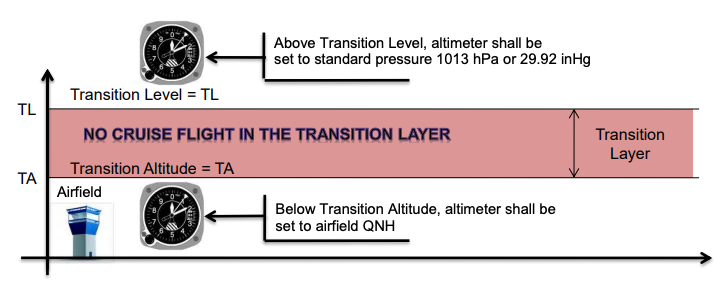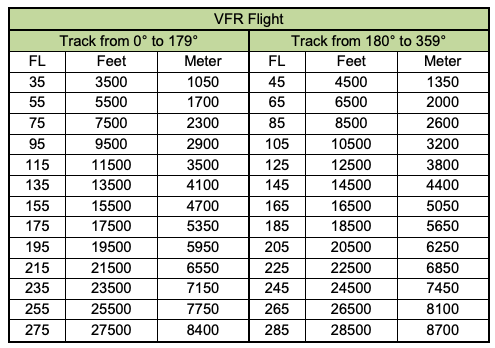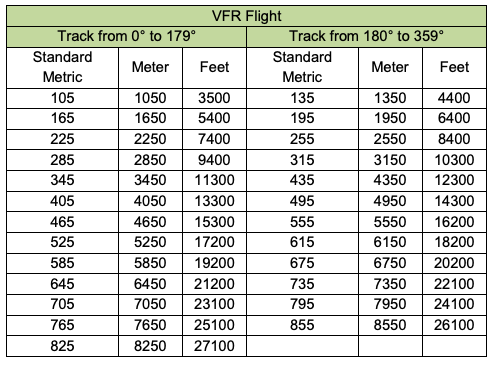¶ Introduction
When you are a VFR pilot, you must take into account when to choose for a cruise altitude or flight level; there are some minimum rules to respect. This article will help you choose one of the possible solutions.
¶ VFR altitude and level restrictions
¶ Minimal altitude
Except for take-off, landing or by emission from the appropriate authority, VFR flights shall be flown:
- At a height not less than 300m (1 000ft) above the highest obstacle within a radius of 600 m from the aircraft over the congested areas of cities, towns or settlements or over an open-air assembly of persons.
- At a height not less than 150m (500ft) above the ground or water except over the congested areas of cities, towns or settlements.
Some countries adopt a minimum height above 1000ft over natural parks and reserves. Some countries also require a minimum height of flight between 1000ft to 5000ft over cities.
¶ Maximum altitude or flight level
VFR civil flights shall not fly above FL200.
For military aircraft, please consult Special Operation Department for HQ rules or the Special Operation rules of your division to have the exact limitations.
¶ Cruise altitude or flight level selection
¶ Free altitude?
VFR flights in level cruising flight when operated below 900 m (3 000 ft) from the ground or water are free.
Above this previous altitude, the cruise altitude or flight level is not free. You must choose it according to the semi-circular rules (see next chapter).
A higher level can be specified by the appropriate ATS authority.
¶ Transition layer constraints
The transition layer is the airspace between the transition altitude and the transition level.
Consult our altimetry documentation for pilot or controller in order to have more information about transition layer, transition altitude and transition level.
No cruise flight level or cruise altitude can be chosen in the transition layer.

¶ Available VFR levels
Except where otherwise indicated in air traffic control clearances or specified by the appropriate ATS authority, VFR flights when operated above 900 m (3 000 ft) from the ground or water shall be conducted at a flight level/altitudes appropriate to the track as specified in the following levels :
- VFR flights use flight levels ending with the number 5: FL 45, FL 55, FL 135, FL 195...
- VFR flights use altitudes ending with the number 500: 4500ft, 5500ft, 13500ft, 19500ft...
The cruise altitude or cruise flight level must be chosen using this assigned rule and must follow the semicircular rule depending on the heading of the aircraft (see next chapter).
Note that IFR flight levels end with final number 0 and not 5. This provides enough separation between VFR and IFR flights and adequately avoids possible conflicts during the cruise phase.
¶ Odd and even flight levels
In response to the need of flight level separation between the same types of flight, flight levels have been separated in two categories, the even and the odd flight level:
- Even flight level: the last number before the final number 5 shall be even: FL 45, FL 65, FL 125...
- Odd flight level: the last number before the final number 5 shall be odd: FL 55, FL 75, FL 135...
¶ Semicircular rule
¶ Default worldwide semicircular rule
The default worldwide semi-circular rule is the East/West orientation of the flight level parity: Your aircraft's track is between 0° and 179°, your flight level or altitude must be odd. Your aircraft's track is between 180° and 359°, your flight level or altitude must be even

By following the semi-circular rule, a VFR aircraft will limit possible conflicts with another aircraft coming from the opposite direction through providing 1000ft separation between opposite west/east tracks.
¶ Specific semicircular rule
In some counties due to IFR routes or special regulations set by the local administration, the semi-circular rule can be the North/South orientation of the flight level parity:
- Your aircraft's track is between 90° and 269°, your flight level or altitude must be odd
- Your aircraft's track is between 270° and 359° & between 0° and 89°, your flight level or altitude must be even.
¶ List of available flight levels and altitudes
Be aware that no civil VFR flight is allowed above FL195.
Some countries (like Russia) adopt a metric airspace above the transition level.
¶ In a normal airspace

¶ In a metric airspace

- None
- None
- VID 150259 - Creation
- VID 450012 - Wiki integration
- VID 496402 - Wiki.js integration